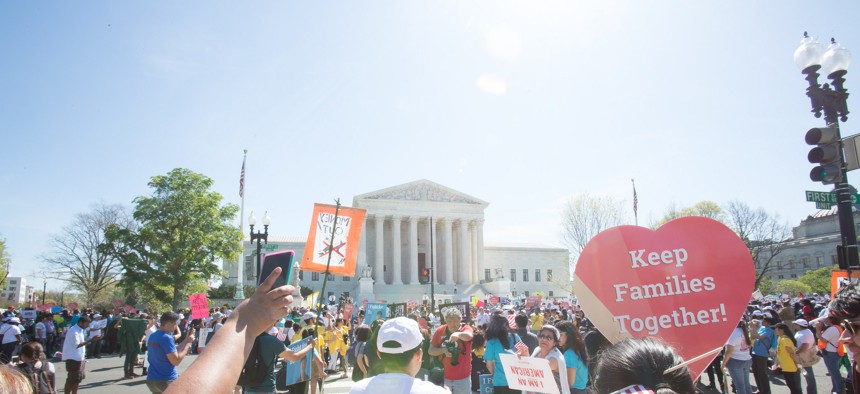
Immigration rights groups rallied at the Supreme Court during oral arguments in April. Flickr user breadfortheworld
A Supreme Deadlock on Immigration
The justices split 4-4 on the Obama administration’s 2014 immigration plan, effectively blocking it.
The U.S. Supreme Court announced a deadlock in a major legal challenge to President Obama’s immigration plan Thursday, effectively crippling the administration’s plans to shield millions of undocumented immigrants from deportation.
The Court announced its paralysis in U.S. v. Texas with a simple eight-word sentence: “The judgment is affirmed by an equally divided Court.”
When the justices split 4-4, the lower court’s decision becomes the last word on the matter. That preserves federal district judge Andrew Hanen’s preliminary injunction against the program, which he issued in February 2015. The Fifth Circuit Court of Appeals, which covers Arkansas, Louisiana, and the border state of Texas, upheld the injunction last November.
The case, United States v. Texas, centered on the Deferred Action for Parents of Americans and Lawful Permanent Residents program, known simply as DAPA. Amid years of intense pressure from immigration-reform activists, President Obama unilaterally created the program by executive order in November 2014 shortly after Republican victories in the midterm elections.
Under DAPA, certain groups of undocumented immigrants already living in the country are eligible for “deferred action,” shielding them from deportation for an additional three years and allowing them to seek lawful employment during that time. Injunctions by lower federal courts have prevented the program from going into effect.
Texas and 25 other states, all of whom were led by Republican governors, immediately challenged the program in court. They argued the administration had not followed the Constitution’s Take Care Clause when enacting the policy. (As my colleague Garrett Epps pointed out in February, nobody really knows what that clause means.) For legal standing to challenge the program, Texas claimed DAPA burdened the states by forcing them to provide government services to thousands of newly shielded undocumented immigrants.
The case now returns to the federal district court for further proceedings. Once those proceedings conclude, it could once again be appealed to the Fifth Circuit and then the U.S. Supreme Court, which may or may not have a ninth justice at that time.
NEXT STORY: Donald Trump's Coalition of Restoration







